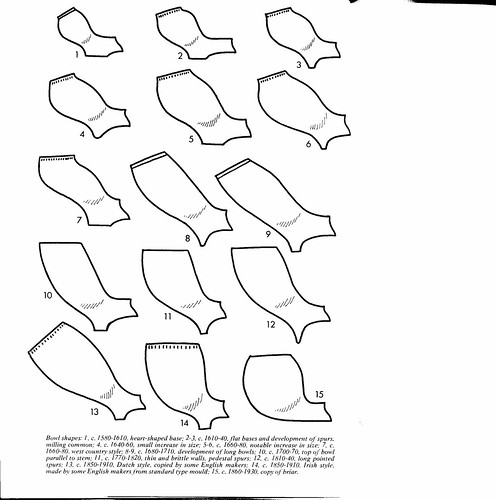.flickr-photo { border: solid 2px #000000; }.flickr-yourcomment { }.flickr-frame { text-align: left; padding: 3px; }.flickr-caption { font-size: 0.8em; margin-top: 0px; }
This diagram, from Clay Tobacco Pipes, Eric G. Ayto, Shire, 2002, shows how the shape changed in England over time, from the 1580s to the early 20th century. Even if you knew nothing of the national history, you could, I suggest, develop a theory of economical development from it.
In the 1580s tobacco was an expensive product, so the bowl was small and carefully cupped (around 6m inside diameter) the product. The bore of the stem only about 3mm. “They are sometimes referred to as plague pipes because of the large numbers found in plague pits during excavation work” – the theory was that tobacco would ward off disease – p. 4.)
From about 1660 onwards, however, (number 5 above), pipes rapidly got larger and over the turn of the century deeper, a trend that only continued right through the history of the pipe – richer nation, relatively cheaper tobacco.
They are not shown in this diagram, but from the middle of the 19th-century onwards fancy patterned pipes appeared, allowing the gentlemen smoker to show his interests – an early form of personal branding. Among those illustrated are footballs, angling gear, vines (for lovers of vino, presumably), jockeys, and political figures.
However, this was largely a middle class product …. “the 19th-century working man preferred his ordinary short clay, which was very cheap and often given away with a pint of beer by the local publican. The shorter pipe had the advantage of reducing the load on the teeth when smoking and working at the same time. This new habit (previously it was usual for a clay pipe to be smoked at leisure with the stem supported in the hand) brought about the production of special short pipes such as the Scottish cutty and the Irish dudheen … Short pipes were often referred to in the north of England as “nose warmers” (p. 10).


 About
About
2 Comments